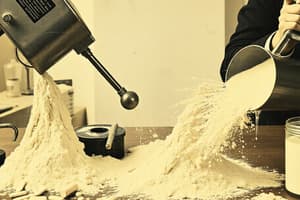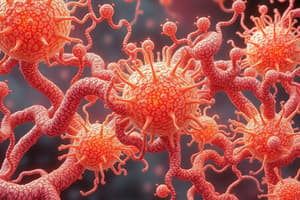Podcast
Questions and Answers
Which statement best describes the benzyl radical?
Which statement best describes the benzyl radical?
- It is prone to forming side products in reactions.
- It quickly undergoes homolytic cleavage in reactions.
- It is unusually stable compared to other radicals. (correct)
- It is highly reactive due to its radical nature.
In the Wolff-Kishner reaction mechanism, what acts as the reducing agent?
In the Wolff-Kishner reaction mechanism, what acts as the reducing agent?
- N2H4 (correct)
- NH2NH2
- N2H2
- H2N-NH2
What is the key role of Grignard Reagents and Lithium salts in metal-halogen exchange?
What is the key role of Grignard Reagents and Lithium salts in metal-halogen exchange?
- They act as catalysts for the exchange reaction.
- They behave like aryl anions, enabling further reactions. (correct)
- They initiate the halogen removal step in the exchange.
- They function as co-solvents to aid in the exchange process.
What type of reaction do benzylic bromides predominantly undergo?
What type of reaction do benzylic bromides predominantly undergo?
Why are Grignard Reagents and Lithium salts considered strong bases?
Why are Grignard Reagents and Lithium salts considered strong bases?
What is the consequence of having an acidic functionality in the presence of Grignard Reagents or Lithium salts?
What is the consequence of having an acidic functionality in the presence of Grignard Reagents or Lithium salts?
What is the major limitation of using Friedel-Crafts alkylation for the synthesis of alkylbenzenes?
What is the major limitation of using Friedel-Crafts alkylation for the synthesis of alkylbenzenes?
In the context of aromatic chemistry, what does AlBr3 act as during the reaction with alkylbenzenes?
In the context of aromatic chemistry, what does AlBr3 act as during the reaction with alkylbenzenes?
Which type of group interconversion is achieved through Metal-Halogen Exchange reactions in the synthesis of substituted benzenes?
Which type of group interconversion is achieved through Metal-Halogen Exchange reactions in the synthesis of substituted benzenes?
What is the primary purpose of using Grignard reagents in organic synthesis?
What is the primary purpose of using Grignard reagents in organic synthesis?
Which reaction mechanism is typically involved in the synthesis of phenol from alkylbenzenes?
Which reaction mechanism is typically involved in the synthesis of phenol from alkylbenzenes?
What type of compound is formed when benzylic bromides undergo reaction with a nucleophile?
What type of compound is formed when benzylic bromides undergo reaction with a nucleophile?
Why are tertiary alkyl substituted benzenes unreactive in the context mentioned?
Why are tertiary alkyl substituted benzenes unreactive in the context mentioned?
Which functional group interconversion reaction involves the use of Sn, HCl followed by an OH group addition?
Which functional group interconversion reaction involves the use of Sn, HCl followed by an OH group addition?
Why is aniline less reactive compared to alkyl amines when reacting with acid chlorides and carbonyl compounds?
Why is aniline less reactive compared to alkyl amines when reacting with acid chlorides and carbonyl compounds?
In the context of benzylic bromide reactions, what role does the formation of benzylic cations play?
In the context of benzylic bromide reactions, what role does the formation of benzylic cations play?
Which reaction mechanism is believed to be complicated and still under debate according to the text?
Which reaction mechanism is believed to be complicated and still under debate according to the text?
What do primary and secondary alkylbenzenes give when reacting, as mentioned in the text?
What do primary and secondary alkylbenzenes give when reacting, as mentioned in the text?
What is the primary function of Grignard Reagents as nucleophiles in organic chemistry?
What is the primary function of Grignard Reagents as nucleophiles in organic chemistry?
In the reaction with carbonyls, what type of product is typically formed when Grignard Reagents act as nucleophiles?
In the reaction with carbonyls, what type of product is typically formed when Grignard Reagents act as nucleophiles?
Which of the following is NOT a common use of Grignard Reagents as nucleophiles?
Which of the following is NOT a common use of Grignard Reagents as nucleophiles?
What are the common products obtained when Grignard Reagents react with epoxides?
What are the common products obtained when Grignard Reagents react with epoxides?
In functional group interconversions, which strong reagent is typically required to convert primary alcohols to benzoic acids?
In functional group interconversions, which strong reagent is typically required to convert primary alcohols to benzoic acids?
Which oxidation reaction of secondary alcohols leads to the formation of ketones under mild conditions?
Which oxidation reaction of secondary alcohols leads to the formation of ketones under mild conditions?
What is the role of AlCl3 in the Gatterman-Koch formylation reaction?
What is the role of AlCl3 in the Gatterman-Koch formylation reaction?
Which drug is NOT derived from phenol according to the text?
Which drug is NOT derived from phenol according to the text?
What is the main function of Wolff-Kishner reaction in organic synthesis?
What is the main function of Wolff-Kishner reaction in organic synthesis?
During the Haworth Reaction, what type of ring closure is typically observed?
During the Haworth Reaction, what type of ring closure is typically observed?
Which method is NOT involved in the preparation of alkylbenzenes after Friedel-Crafts acylation?
Which method is NOT involved in the preparation of alkylbenzenes after Friedel-Crafts acylation?
What is the purpose of Zn(Hg) and HCl in the reduction of acylbenzenes to alkylbenzenes?
What is the purpose of Zn(Hg) and HCl in the reduction of acylbenzenes to alkylbenzenes?
Explain the mechanism of Friedel-Crafts acylation and its significance in organic synthesis.
Explain the mechanism of Friedel-Crafts acylation and its significance in organic synthesis.
Describe the reaction involved in the preparation of alkylbenzenes after Friedel-Crafts acylation.
Describe the reaction involved in the preparation of alkylbenzenes after Friedel-Crafts acylation.
What type of ring closure is typically observed in the Haworth Reaction?
What type of ring closure is typically observed in the Haworth Reaction?
Explain the Wolff-Kishner Reaction and its role in organic synthesis.
Explain the Wolff-Kishner Reaction and its role in organic synthesis.
Discuss the bromination mechanism involved in the synthesis of alkylbenzenes and its significance.
Discuss the bromination mechanism involved in the synthesis of alkylbenzenes and its significance.
Flashcards are hidden until you start studying





